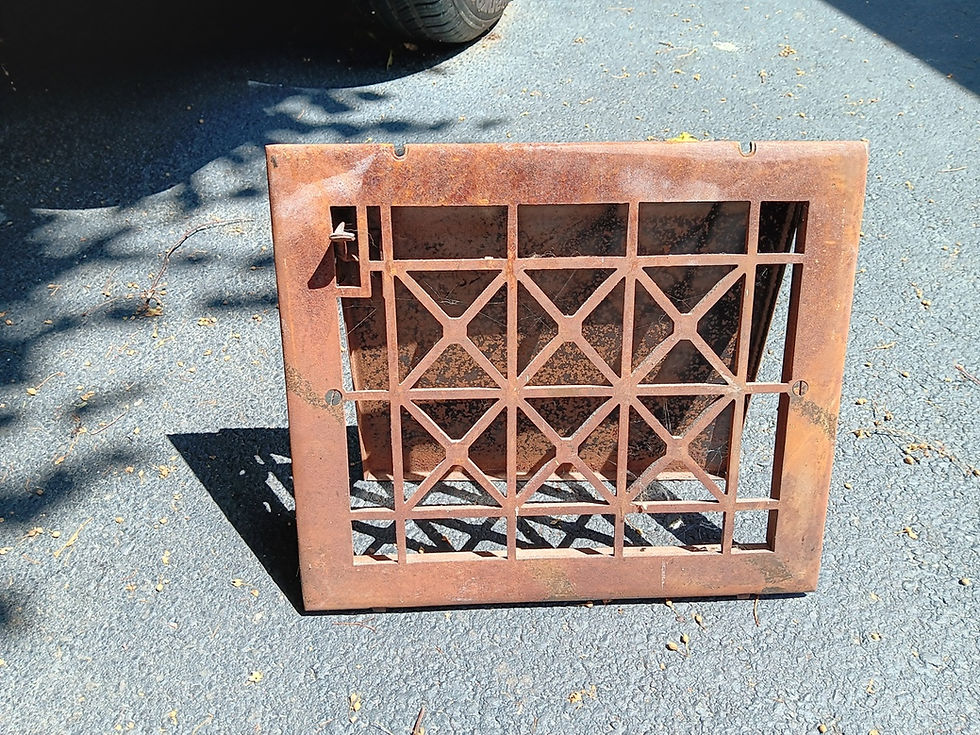Ideas from Ed: Just A Sprung Spring
- LCP4P

- May 2, 2020
- 4 min read
Updated: Nov 23, 2020
“Ideas from Ed” (May 2020)
Ed is a do-it-yourselfer who is happy to share some of his ideas and experiences in this monthly column.
This month: Just a sprung spring (mortise lock repair)
Most folks who own an old house have at least a few doors with old-fashioned mortise locks. The mechanisms were relatively bullet-proof, even with generations of kids slamming doors and over-twisting knobs, etc. However, the “weak link” so to speak is a tiny spring that operates the protruding “catch” that snaps into the recess on the door casing, to hold the door closed. This month, we’ll take a break from the very long, drawn-out articles I’ve been writing lately, and look at this very simple repair.
Here’s a lock typical of which I speak. Notice that the protruding catch isn’t protruding. It can be worked by turning the knobs, but it should snap out and have some resistance when pushed back in.

The knobs have to come off first. Actually, only one has to be undone, but both must be removed from the door. Find the setscrew holding one knob in place, and carefully undo it. Try not to drop the screw, and as one knob is pulled off, watch for thin washers that might be on the shaft. Those are sometimes needed to take up a little bit of “play” if the knob cannot be placed onto the shaft at a location without “wiggling and wobbling” too much. Here’s the setscrew being undone, and the door once knobs are off. This particular door did not have any of the thin washers. As is normal, lefty-loosey and righty-tighty.


Next, the lock mechanism must be pulled from the mortise in the door. Usually there are only two screws that hold it in place, at the top and bottom of the plate at the door edge. While the screws are usually easily undone, sometimes years of paint or varnish, or even just dust and dirt, will seem to have “glued” the mechanism in place. With the screws out, you can pry gently at the knob shaft, or perhaps in the endplate holes to slip the unit out. You can see in this picture that someone has pried things out in the past, as the wood around the endplate shows damage. Be careful and go easy so you don’t have to make repairs to the wood.


Not every mortise lock looks exactly like this one, but millions of them do, and those that don’t are very similar. There is generally one side without a hold-together screw, and one with the screw.


Set the unit on a flat surface, and gently undo the screw so the cover can be removed. Once it has been removed, I suggest taking a picture of the innards with your camera or phone. There are usually about 6 or 8 parts within the case, and they must be kept in the right location for proper function. They are easily dislodged, since it’s only the case cover that holds them in place. Having the photo gives you a chance of reassembling things should a piece slip out of position. Some pieces are machined, some are cast, and some may be spring steel, and everything will fall out of position if you’re not careful. Then it’s time for your detective work, to ascertain the malfunction. Most of the time the culprit (per the title of this article) is a spring. In MY case, the spring was actually missing. Yours may be just broken or worn out. You may need to play around with the door catch and look for spring anchoring points. The spring is most likely one that “wants to extend”, but depending on the lock, it could be one that “wants to retract” if the anchoring points indicate it. In any case, you will want the “normal” or “at ease” position to be such that the catch is extended (not retracted) out of the housing. Of course, you should be able to push it in with your finger against spring tension, and the spring must return the catch to the normal position.
Take your old spring to a good hardware store and do your best to match it up with a replacement one. With mine being missing, I had to guess a bit on the exact length and strength. It ended up being similar to one from a ball-point pen but a bit more stout.

The spring simply plopped into position. Then the cover was carefully re-attached, making sure all internal components stayed in position.

Installation was exactly the reverse of removal — insertion into the door, 2 retaining screws, doorknobs pushed into position for best fit without excess play, and the knob retaining screw inserted and tightened. Pro tip: I find that those pesky knob setscrews always seem to come loose. A single drop of thread-locker onto it prior to tightening will keep the setscrew in place until you need to remove it again. Try to position the setscrew so that insertion is from below so that it’s not visible.
I hope all your projects go well. Thanks for reading, and happy restoring!
Ed




If your door lock is not working smoothly and wants to repair it, always employ locksmith miami experts because they have the experience to deal with all types of door locks at a low cost.